
HMS Loch Fada was the lead ship of the Loch-class frigates of the British Royal Navy, built by John Brown & Company of Clydebank, Scotland, and named after Loch Fada in the Inner Hebrides.
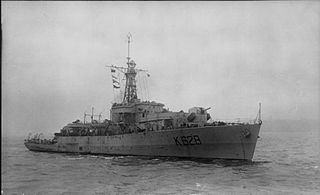
HMS Loch Killisport (K628/F628) was a Loch-class frigate of the British Royal Navy, named after Loch Killisport in Scotland. Launched in 1944, the ship was not commissioned until July 1945, and served in post-war repatriation operations in the Far East until decommissioned in April 1946. During this time Prince Philip was an officer on board this ship. Recommissioned in 1950 she served in the Home Fleet for two years, before being extensively modernised for service in the Persian Gulf and Far East. Decommissioned in August 1965, she was sold for scrapping in 1970.

HMS Naiad (F39) was a Leander-class frigate of the Royal Navy (RN). Like the rest of the class, Naiad was named after a figure or figure of mythology, in this case, the Naiads of Greek mythology. Naiad was built by Yarrow Shipbuilders of Scotstoun. She was launched on 4 November 1963 and commissioned on 15 March 1965.
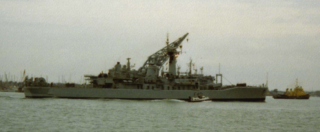
HMS Sirius (F40) was a Leander-class frigate of the Royal Navy (RN) built by H.M. Dockyard Portsmouth, and was the penultimate RN warship to be built there for a period of forty years, until Vosper Thornycroft built HMS Clyde. Sirius was launched on 22 September 1964 and commissioned on 15 June 1966. The ship continued in front line service until February 1992.

HMS Duncan, launched in 1957, was the fifth RN ship named after Admiral Adam Duncan. She was a Blackwood-class frigate of the Royal Navy that served in the Cod Wars.

HMS Nautilus was a Beagle-class destroyer of the Royal Navy. She was commissioned on 30 March 1910 from Thames Ironworks & Shipbuilding Company. She was renamed HMS Grampus on 16 December 1913, her former name being reallocated to HMS Nautilus, the first Royal Navy submarine to be given one.

HMS Yarmouth was the first modified Type 12 frigate of the Rothesay class to enter service with the Royal Navy.

HMS Tireless, a Taciturn- or T-class submarine, was the first ship of the Royal Navy to bear that name. She was authorized under the 1941 War Emergency Programme and her keel was laid down on 30 October 1941 at Portsmouth Dockyard. She was launched on 19 March 1943 and was completed on 18 April 1945.

HMS Forth, pennant number F04 later A187, was a submarine depot ship.

HMS Dundas was a Blackwood-class anti-submarine warfare frigate of the Royal Navy.

HMS Grafton was one of a dozen Blackwood-class frigate of second-rate anti-submarine frigates built for the Royal Navy in the 1950s.

HMS Rothesay was the lead ship of the Rothesay or Type 12M class of anti-submarine frigates of the British Royal Navy. She was commissioned in 1960 and scrapped in 1988.
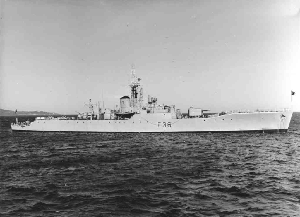
HMS Whitby was a Whitby-class or Type 12 anti-submarine frigate of the Royal Navy of the United Kingdom built by Cammell Laird and Co Ltd, Birkenhead. She was launched on 2 July 1954 and commissioned on 10 July 1956.

HMS Undaunted was a U-class destroyer of the British Royal Navy that saw service during World War II. She was later converted into a Type 15 fast anti-submarine frigate, with the new pennant number F53.

HMS Wakeful was a W-class destroyer of the Royal Navy launched in 1943. She saw service during the Second World War and was later converted into a Type 15 fast anti-submarine frigate. She was sold for scrap in 1971.
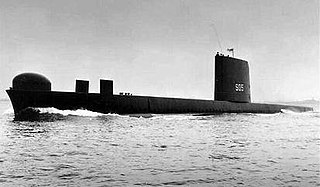
HMS Finwhale (S05) was the fifth Porpoise-class submarine of the Royal Navy. She was launched on 21 July 1959 and first commissioned on 19 August 1960.
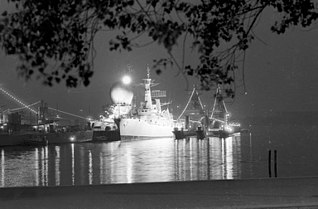
HMS Walrus (S08) was the last of the Porpoise class submarines of the Royal Navy. She was launched on 22 September 1959, and commissioned on 10 February 1961.

HMS Loch Fyne was a Loch-class frigate of the British Royal Navy, built by the Burntisland Shipbuilding Company Ltd, Burntisland, Fife, Scotland, and named after Loch Fyne in Scotland. The ship was launched in 1944, and served at the end of World War II. Recommissioned in 1951, she served in the Persian Gulf and was scrapped in 1970.

HMS Sturgeon was an S-class submarine that entered service with the Royal Navy in 1932. Ordered in 1930, she was laid down at Chatham Dockyard in January 1931 and launched on 8 January 1932. Commissioned on 27 February 1933, Sturgeon was assigned to the 2nd Submarine Flotilla.

HMS Token was a British submarine of the third group of the T class. She was built as P328 at Portsmouth Dockyard, and launched on 19 March 1943. So far she has been the only ship of the Royal Navy to bear the name Token.




















